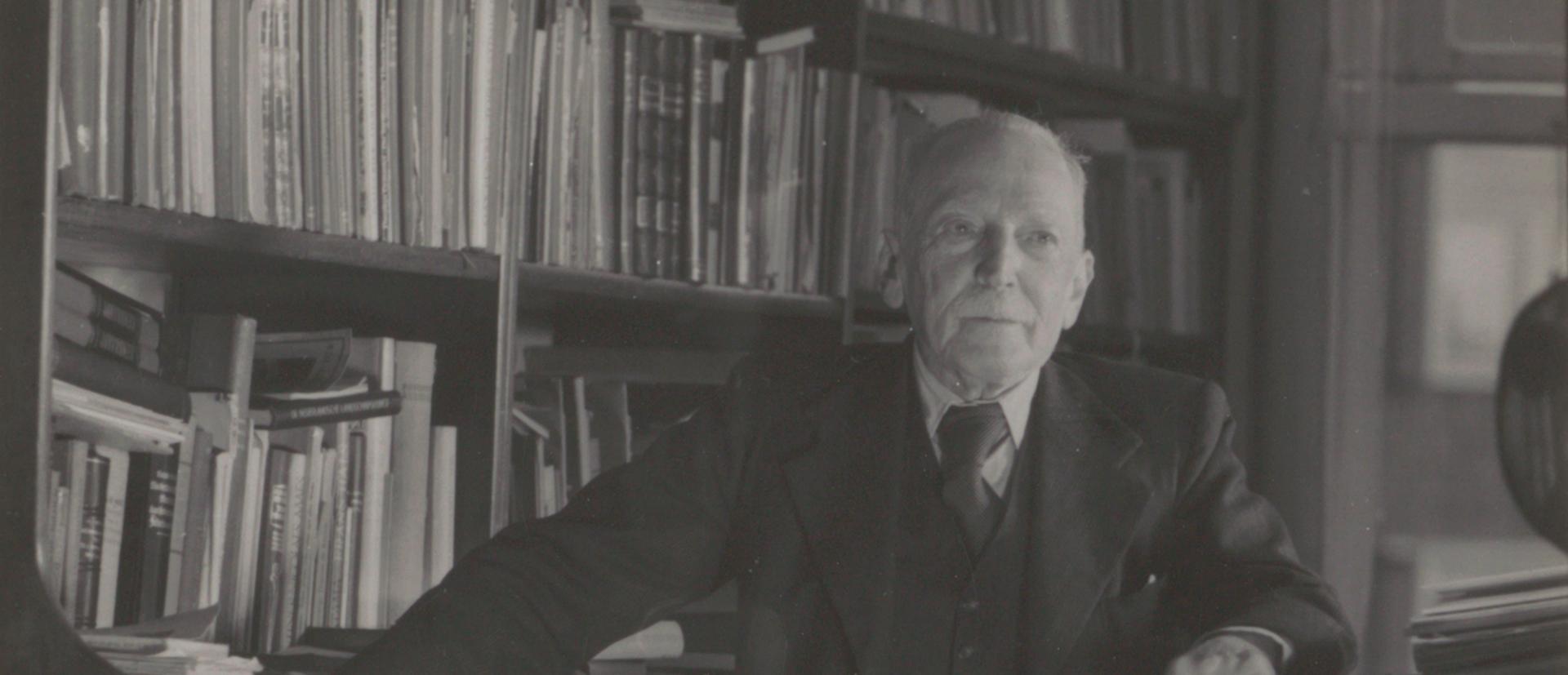RKD acquires former desk of Max J. Friedländer

Recently, the RKD received a unique donation: a desk from the estate of the German art historian Max J. Friedländer (1867-1958). Having been in the depot of Museum Rotterdam for years, the piece is now on show in the anniversary exhibition of the RKD. The mahogany secretary desk in Empire style is a wonderful addition to Friedländer’s archive, which was already part of the RKD’s collection.
Contacts of old
Long before the RKD was established, Cornelis Hofstede de Groot (1863-1930), founder of the Netherlands Institute for Art History, maintained close connections with his German colleagues. With Wilhelm Bode (1845-1929), the celebrated Berlin museum director, he shared an interest in the great Dutch masters, such as Rembrandt and Frans Hals. He also regularly crossed paths with Bode’s right-hand man, Max Friedländer, connoisseur extraordinaire of early Netherlandish painting; they often met at exhibitions and during auctions, where they exchanged the latest news.
Hans Schneider (1888-1953), the first director of the RKD, kept up the close ties with Friedländer. When, after 1933, the latter found himself in increasingly hot water because of his Jewish descent, Schneider extended a helping hand. Friedländer was given the opportunity to establish himself in The Hague with the aid of the Art Historians Fund (Kunstgeleerdenfonds), which was closely allied to the RKD. In exchange and as a token of his gratitude for the tireless efforts of Schneider as well as his deputy during the war Jan van Gelder (1903-1980), he bequeathed his study material to the RKD. The many thousands of photographs of fifteenth- , sixteenth- and seventeenth-century paintings annotated by Friedländer, as well as a selection from his library, were an enriching addition to the budding institute’s collection.

3. Cornelis Hofstede de Groot, Dirk Hannema (Museum Boijmans), Frederik Schmidt-Degener (Rijksmuseum) and Max Friedländer at an auction in Berlin, 1929, collection RKD
Friedländer archive
Donations by Friedländer’s heirs have meant that in the past few years, the archive was able to further expand with even more study material, such as art-historical notes, manuscripts and notebooks, and more recently with photographs and other personal pieces. The Empire style mahogany secretary desk, which is now part of the RKD’s Friedländer archive, forms a splendid addition. This piece of furniture can be seen in a photograph from 1949, printed in a 1955 issue of the Swiss magazine Du, as part of an interview Friedländer gave to Hans Naef. It shows the art scholar, by that time quite advanced in years, dressed in a three-piece suit with pocket watch in his apartment on the Beethovenstraat in Amsterdam. One hand is holding on to a ceiling-high bookcase, while the other rests on the desk.

2. Max Friedländer in his appartment on the Beethovenstraat in Amsterdam, 1949, collection Fondation Custodia, Vitale Bloch archive
Museum Rotterdam
In 1959, the Historical Museum Rotterdam (now Museum Rotterdam) purchased the desk from Friedländer’s estate at Amsterdam auction house Paul Brandt. The interest the piece held had little to do with its previous owner but instead was driven by the furnishing of one of the period rooms in Het Schielandhuis, where the museum was located at the time. The Historical Museum Rotterdam was not the only museum that secured a lot from Friedländer’s estate. The Gemäldegalerie in Berlin, the museum where Friedländer had started out as scientific assistant under Bode and had left as the latter’s successor, managed to obtain a sixteenth-century fragment of a bigger painting that Friedländer had attributed to the Brunswick Monogrammist (active around 1525-1555), while the Rijksprentenkabinet (Rijksmuseum Printroom) in Amsterdam purchased several drawings by the versatile Berlin artist Adolph Menzel (1815-1905).

2. Adolph Menzel, Sketch of a man with a hat, drawing in charcoal, Rijksprentenkabinet, Amsterdam
3. Page from the manuscript of Von Kunst und Kennerschaft, collection RKD, Max J. Friedländer archive
Authorship
The desk the Rotterdam museum acquired to decorate one of its period rooms is not merely interesting by reason of its former owner, but also because it represents an era in which the art historian used to write his texts by hand. In the Friedländer archive, there are a number of manuscripts of articles and books, including two manuscripts of the widely praised Von Kunst und Kennerschaft (On Art and Connoisseurship), in which the aspects and importance of intuitive connoisseurship are explained. The sheets in landscape format which make up the manuscript, are covered in writing for about two-thirds of the page in a regular handwriting, the wide righthand margin being designated for corrections.
Nowadays it is hard to imagine the amount of work that went into writing a book. Whether Friedländer spent endless hours toiling away at his desk it is now impossible to determine. That he had strong views on what art historians should and should not commit to paper is, however, clear beyond all doubt: “Wenig Aussicht hat man, etwas Neues, zugleich Richtiges zu sagen – “was nicht die Vorwelt schon gedacht“ – Deshalb alle Mühe darauf verwenden, deutlich, verständlich zu sagen, was man etwa zu sagen hat, ohne den Ehrgeiz, Neues zu sagen.“ (“One has little chance of saying something new and at the same time correct – “what the world before has not already thought” - Therefore, make every effort to say clearly and understandably what one has to say, without the ambition to say something new.”)
The donation was made in accordance with the Guideline for the Disposal of Museum Objects (Leidraad Afstoting Museale Objecten - LAMO).
With thanks to Liesbeth van der Zeeuw, curator arts and crafts, Museum Rotterdam.